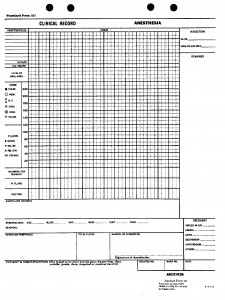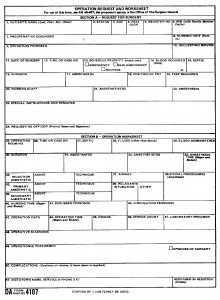During a surgical procedure, the circulator must be alert to the needs of both the surgeon and the scrub.
He should anticipate what will be needed and have the supplies and equipment available. The following paragraphs set forth procedures that the circulator is to follow.
a. Do not leave the room unless you are sent for equipment or supplies or you are relieved by another circulator. If you are leaving the room to obtain equipment or supplies, notify the scrub and anesthetist and return as quickly as possible. If the supplies or equipment cannot be obtained quickly, notify the operating room supervisor or the noncommissioned officer in charge (NCOIC) and return to the operating room.
b. When a general anesthetic is being administered, stay at the patient’s side. If it is necessary to move in the anesthesia area, use smooth, careful movements.
c. Watch to see what the scrub needs and furnish this material.
d. Keep the operating room light adjusted so that there is no shadow on the operative area. If the light appears to need adjustment, ask the surgeon’s permission before refocusing the light. Keep well away from the sterile field while adjusting the light.
e. Keep the room neat by removing sponges, instruments, bits of suture, etc., from the floor. Use an unsterile sponge forceps to pick up soiled sponges (for your protection, do not pick them up with your hands) and then place them in such a way that will facilitate counting. Pick up sponges as they are discarded and do not allow them to accumulate. Put them in an area where they can be observed by the surgeon, the anesthetist, and the scrub.
f. Keep the saline in the basins warm, if required, by adding hot solution as necessary.
g. Prepare appropriate size specimen jars (with lids) to receive the specimen.
(1) Formalin solution, 10%, is used for routine specimens of tissue (check with the surgeon before placing the specimen into the solution).
NOTE: Formalin should NEVER be in the operating room when a patient is in the room.
(2) Normal saline solution is used in the following instances.
(a) Tissue specimens are to be examined for the presence of tuberculosis organisms.
(b) Tissue specimens are to be photographed (formalin discolors tissue). Once a routine specimen has been photographed, it may be placed in 10% formalin solution.
(c) Tissue specimens are to be prepared for frozen section. Tissue will be placed in a specimen container, labeled, and sent to Pathology immediately.
h. Prepare the appropriate forms, such as the SF 515 (Tissue Examination) according to local policy. Also, write the information required by local policy on a gummed label and stick it on the specimen jar. (Such information should include at least the patient’s name and register number, the name of the operation, the surgeon’s name, the date, and the kind of tissue included for examination.) This precaution ensures that the specimen can be identified with the appropriate patient in case the pathology forms are lost.
i. Turn on the suction machine when all furniture is moved in place.
j. According to local procedure, prepare two copies of the appropriate anesthesia record, SF 517 (Clinical Record – Anesthesia) by stamping it with the patient’s hospital card (see Figure 4-1).

k. Take the sponge count with the scrub and a registered nurse. Make sure that you see each sponge.
l. Prepare the adhesive strips and any other materials required for dressing the patient’s wound.
m. Fill out an “Operative Sheet” or “Buck Slip” according to local policy. Record in appropriate places on this sheet identifying information about the patient, the name of the operation (procedure), the tissue specimen, and the names of the surgeon, the anesthetist, the scrub, and the circulator. A sample of DA Form 4107, Operation Request and Worksheet, is illustrated in Figure4-2.

n. If you are relieved during the operation, instruct the new circulator on what is taking place before you leave the room. You must also do a “turn over count” of sharps and sponges before you leave the room.
